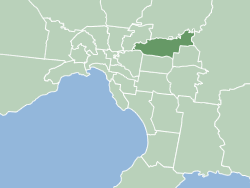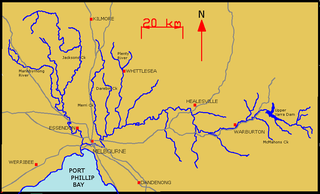
The Yarra River or historically, the Yarra Yarra River, is a perennial river in south-central Victoria, Australia.

The City of Manningham is a local government area in Victoria, Australia in the north-eastern suburbs of Melbourne and is divided into 12 suburbs, with the largest being Doncaster and Doncaster East. It comprises an area of 113 square kilometres and had a population of 125,508 in June 2018.

Warrandyte is built on the lands of the Wurundjeri people of the Woiworung language group of the Kulin Nation, a suburb of Melbourne, Victoria, Australia, 24 km north-east of Melbourne's Central Business District, located within the City of Manningham local government area. Warrandyte recorded a population of 5,541 at the 2021 census.

Wonga Park is a locality on the edge of Greater Melbourne, beyond the Melbourne Metropolitan Urban Growth Boundary area, 33 kilometres (21 mi) north-east from Melbourne's Central Business District, located within the Cities of Manningham and Maroondah and the Shire of Yarra Ranges local government areas. Wonga Park recorded a population of 3,843 at the 2021 census.

Doncaster East is a suburb of Melbourne, Victoria, Australia, 20 km east of Melbourne's Central Business District, located within the City of Manningham local government area. Doncaster East recorded a population of 30,926 at the 2021 census.

The Maribyrnong River Trail is a shared use path for cyclists and pedestrians, which follows the Maribyrnong River through the north western suburbs of Melbourne, Victoria, Australia.
Yarra Scenic Drive is a tourist drive following the Yarra River, in Victoria, Australia. The route traverses approximately 60 km from Williamstown – where the Yarra empties into Port Phillip Bay – to Warrandyte – Melbourne's first goldfield site on the banks of the Yarra.
North Warrandyte is a suburb of Melbourne, Victoria, Australia, 25 km north-east of Melbourne's Central Business District, located within the Shire of Nillumbik local government area. North Warrandyte recorded a population of 3,027 at the 2021 census.

Melbourne is Australia's second largest city and widely considered to be a garden city, with Victoria being nicknamed "the Garden State". Renowned as one of the most livable cities in the world, there is an abundance of parks, gardens and green belts close to the CBD with a variety of common and rare plant species amid landscaped vistas, pedestrian pathways, and tree-lined avenues, all managed by Parks Victoria.

Mullum Mullum Creek is a creek in the outer eastern suburbs of Melbourne, Victoria, Australia. It is the main watercourse of the Mullum Mullum Valley, a tributary of the Yarra River and Yarra Valley. For tens of thousands of years it was used as a food and tool source sustainably by the Wurundjeri people, Indigenous Australians of the Kulin nation, who spoke variations of the Woiwurrung language group.

Gardiners Creek, originally known as Kooyongkoot Creek, is an urban stream in the eastern suburbs of Melbourne, and part of the Yarra River catchment.

The Main Yarra Trail, also known as the Yarra Trail is a shared-use path for cyclists and pedestrians, which follows the Yarra River through the northeastern suburbs of Melbourne, Victoria, Australia.

The Yarra River is a river in East-Central Victoria, Australia that flows through the city of Melbourne. This article contains explanations and lists of the river's tributaries and other geographic features. The river flows atop layers of silt that built up within an ancient river valley around 10,000-15,000 years ago.
The South Waratah Colliery was a coal mine located at Charlestown, in New South Wales Australia.

The Yarra River is a river in southern Victoria, Australia that flows through the city of Melbourne. There are many parklands, including state parks and national parks, that adjoin the river along its 250 km length. Every park listed has walking tracks, smaller parks usually have unsealed paths, while bigger parks will have sealed pathways suitable for walking and cycling. The Yarra River Trail runs along much of the length of the river's lower reaches through Melbourne. Most parks listed have parking available, the quality and quantity of which varies according to the size of the park. Dogs are not permitted in parklands adjoining the river unless otherwise stated in special off-lead areas.

Andersons Creek is a creek in Warrandyte and Park Orchards, east of Melbourne, Victoria, Australia. It is a tributary of the Yarra River. For tens of thousands of years it was used as a food and tool source sustainably by the Wurundjeri people, Aboriginal Australians of the Kulin nation, who spoke variations of the Woiwurrung language group.

The Pound Bend Tunnel, or the Evelyn Tunnel, is a diversion tunnel on the Yarra River at Warrandyte, Victoria, Australia, approximately 24 km north-east of Melbourne. The tunnel is 145 metres long, six metres wide and four metres deep.
The Island is located at Thompson Bend on the Yarra River at Warrandyte, Victoria, Australia, approximately 24 kilometres (15 mi) north-east of Melbourne. It was created by gold miners in 1859–60, during the Victorian gold rush. They dug a diversion channel to alter the course of the Yarra River, providing access to the alluvial gold in the exposed river bed. The canal was widened by subsequent flooding becoming the main river course, with the previous river bed becoming a willow-choked backwater.
Brushy Creek is a tributary of the Yarra River in Melbourne. The creek rises in Mooroolbark Heights and passes through a mixture of underground channels and floodways through the east of Mooroolbark, until it returns to an open waterway through central Mooroolbark. From Mooroolbark it continues downstream through Croydon and passes under the Maroondah Highway, where it flows through Croydon North, Chirnside Park and Wonga Park until it joins the Yarra River in the Warrandyte State Park.


















